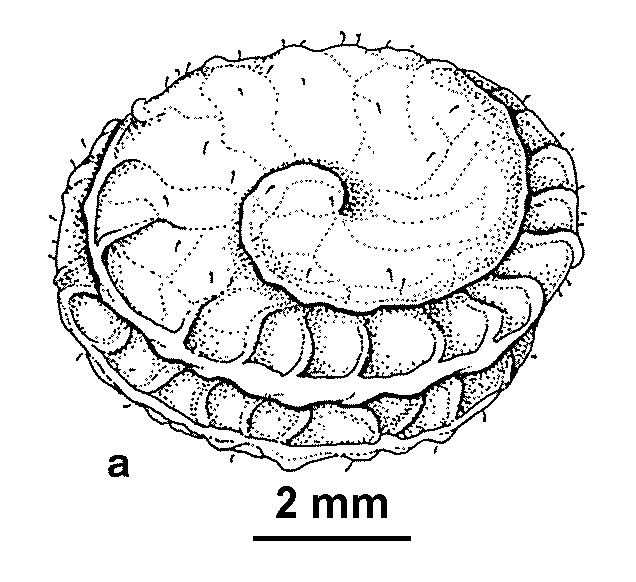Medicago rugosa
Desr. MedicProstrate or decumbent annual herb; stems 30–40 cm long, covered with a mixture of simple and glandular hairs. Leaflets obovate to oblanceolate, 5–23 mm long, 3–19 mm wide, serrate towards apex, upper surface glabrous, lower surface appressed-hairy, apex rounded or truncate with a terminal tooth; stipules to c. 10 mm long, ruggedly toothed, lower surface hairy. Inflorescence 1–7-flowered; peduncle 0.5–2 cm long, equal to or shorter than subtending petiole. Pedicels to c. 2 mm long; calyx 2.5–3 mm long, teeth shorter than or equal to tube; corolla yellow; standard 2.5–4 mm long; wings slightly shorter than keel. Pod with 2.5–5 moderately loose coils, discoid to short-cylindric, 1–3 mm long, 5–10 mm diam., glabrescent with glandular hairs, spineless; coil edge thin; face with 8–18 slightly curved radial veins, anastomosing soon after leaving centre, thickening near edge and obliquely joining the elevated dorsal suture; grooves absent; seeds 1–3, to c. 4.5 mm long, yellow to brownish. Flowers spring.
Wim, VRiv. Native to Europe, northern Africa, the Middle East. In Victoria known only from a single 1986 collection from Nurcoung Lakes Reserve near Horsham.
Even in its native habitat this species is sporadic in occurrence, probably due largely to its spineless pods and its requirement for heavy clay soils.
Jeanes, J.A. (1996). Fabaceae. In: Walsh, N.G.; Entwisle, T.J., Flora of Victoria Vol. 3, Dicotyledons Winteraceae to Myrtaceae, pp. 663–829. Inkata Press, Melbourne.
 Spinning
Spinning
